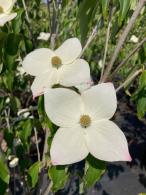Get Additional 5% Off 1st Order
Rosa Silver Anniversary
1. Add items to basket
2. Go to the basket
3. Enter your postcode in Delivery Price Check
Rosa Silver Anniversary or the Silver Anniversary Rose is a beautiful addition to any garden or landscape. Its distinct white flower colouring, fragrance and discrete presence balances the colour and flow of your garden or patio as a welcomed addition. A hardy variety of the Rosaceae family, the Silver Anniversary Rose is a popular choice even in more exposed areas such as windy / coastal. The Rosa genus itself generally exhibits differing growth habits. They are deciduous by nature, can have a semi-evergreen shrub appearance, or a climbing growth habit and will sprout thorny stems. The Silver Anniversary Rose is a hybrid tea or bushy rose. It is shorter in stature and has an upright growth habit. This rose has a beautiful, creamy-white mildly fragrant flower which blooms alone or when in groups, clustered 2 or 3 at a time.
The Rosa Silver Anniversary grows to 0.5-1.0 metres in height with large, double white flowers of 10cm in diameter in summer and autumn. Typically, they will sprawl to about 0.1-.5 metres wide and can take 2-5 years to reach full height. The colour matches the name and is a favourite as a gift for those celebrating their 25th wedding anniversary!
Choose soils that are rich in organic matter and humus but also have good internal drainage. They will take advantage of the moist soil and organic nutrients for year round feeding but their tender roots will not tolerate wet feet so avoid water laden soils. They should receive annual applications of a well balanced fertiliser and mulch in the late winter or early spring with a follow up application of a balanced fertiliser again in early summer. The pH range should be from slightly acid to slightly alkaline. They prefer full sun, but can do well in west or east-facing environments as well.
Roses can be pruned from late winter, usually mid-February. With the tea rose such as Rosa Silver Anniversary, it’s best to prune low on the bush so as to promote vigorous new shoots. This is unlike the floribunda stem, which is left longer with more buds to form flowers in clusters. All roses should first be pruned so as to remove dead, diseased, malformed, or crossing stems…always cut out a crowded bush so as to keep the centre open.











